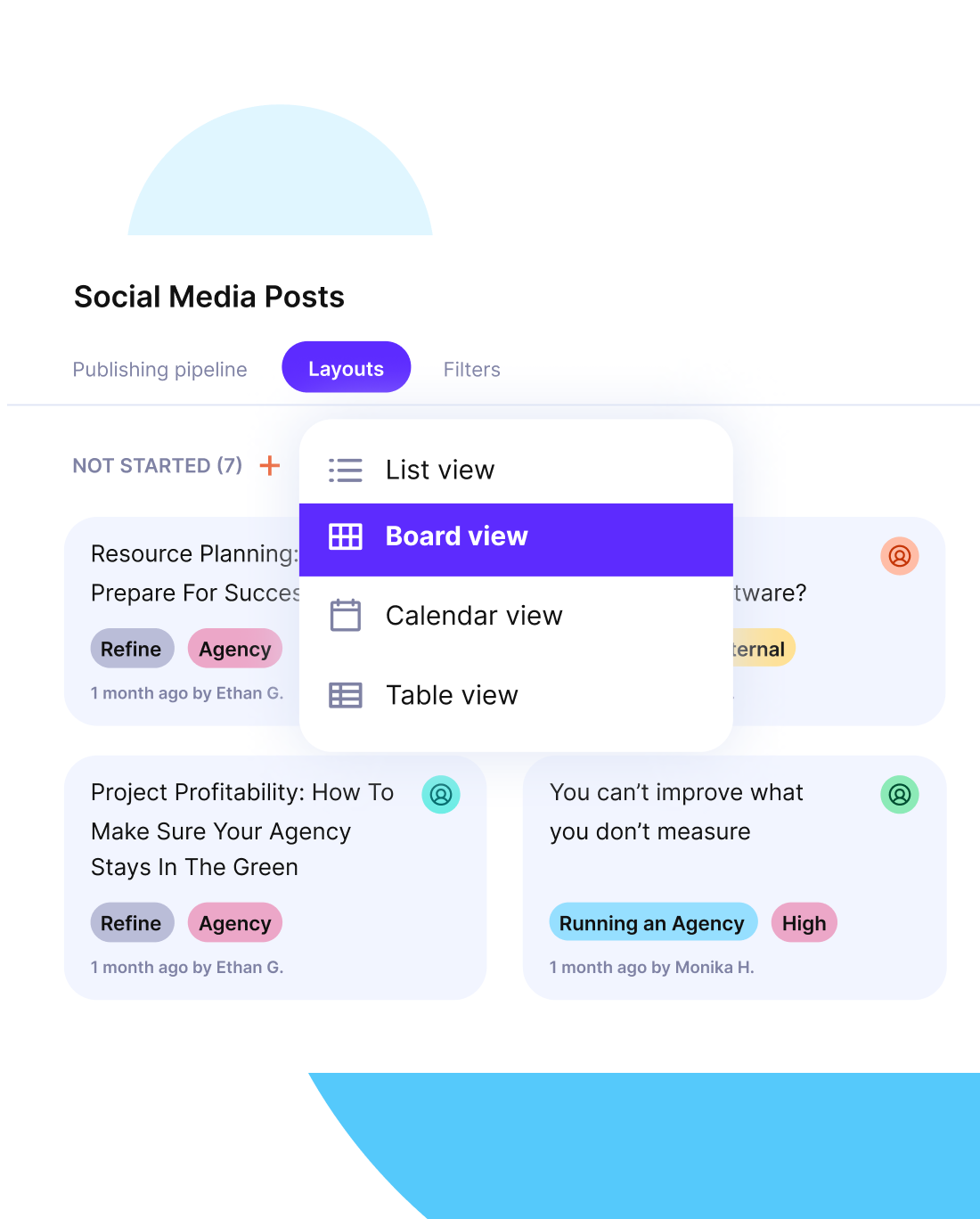What Is a Project Roadmap: Step-by-Step Guide + Example
A missing or poorly defined project roadmap often leaves teams stuck with shifting priorities, unclear goals, and deadlines that are easy to miss. A well-built roadmap gives your team a shared view of where the project is going and how everyone’s work fits together.
Should you make one or not is a no-brainer.
In this detailed guide, you’ll learn exactly what a roadmap is, how to build one step by step, how to avoid common challenges, and which tools help your teams track and deliver as planned.
Key Takeaways
- A project roadmap brings clarity and aligns the entire team around shared objectives.
- It highlights key milestones, giving everyone markers to measure progress.
- Roadmaps show the essential elements of a project at a glance, from deliverables to timelines.
- They keep project management goals visible, so teams can stay focused and adapt change better.
What Is a Project Roadmap?
A project roadmap is a high-level overview that visually communicates a project’s goals, timeline, and major milestones, giving teams and stakeholders a clear strategic direction. To give you more context, it’s useful to highlight how it differs from other closely related project documents.
Roadmap vs. Project Plan
A project roadmap is a strategic overview that outlines high-level goals and timing, while a project plan provides detailed execution steps, resources, and task assignments. Roadmaps answer “what and why,” whereas plans focus on “how and when.”
Good project planning depends on using both the roadmap for strategic direction and the plan for detailed execution together.
Roadmap vs. Product Plan
A project roadmap outlines the path for a single initiative, while a product plan looks at the long-term evolution of a product across multiple projects or releases.
For example, a roadmap might show milestones for launching a new feature, while a product plan would show how that feature fits into the product’s growth over the next year.
Roadmap vs. Project Charter
Roadmaps provide an evolving visual overview, whereas a project charter is a static document that authorizes the project, defines its project scope, and assigns roles. The charter might state the project’s objectives and budget, while the roadmap shows when key milestones and deliverables will be met.
Roadmap vs. Project Backlog
A roadmap sets the strategic direction and major deliverables, while a backlog is a prioritized list of tasks or features to be completed. For example, Agile roadmaps could show a release every quarter, and the backlog would contain the detailed tasks required to make that release happen.
What Are Key Components of a Project Roadmap?
The key components of a project roadmap are goals, milestones, deliverables, and timelines. All of them provide the structure needed for clarity and alignment. Below, we explain each component in detail to show its specific role.
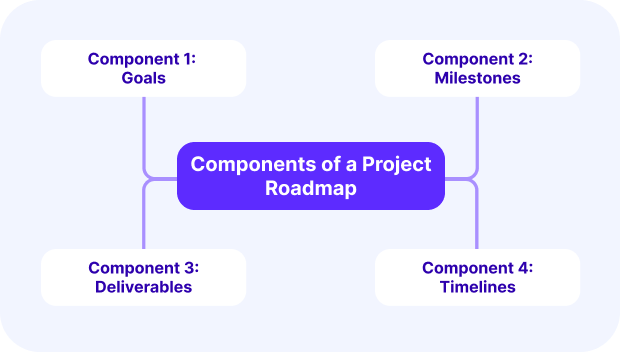
Component 1: Goals
Goals define the desired outcomes of the project and give direction to the project team. They are like anchors, showing why the work matters. For example, in a website redesign project, a clear goal might be to improve conversion rates by 20%.
This goal sets the focus for all other elements and connects directly to broader objectives.
Component 2: Milestones
Milestones are major checkpoints that mark progress toward goals. They break large efforts into manageable stages. For instance, completing user research before moving into design is a milestone that ensures informed decisions.
Milestones help everyone measure progress and adjust if the project falls behind schedule.
Component 3: Deliverables
Project deliverables are the tangible outputs that the team must produce. These could be documents, designs, or working prototypes. In a marketing campaign, a deliverable might be the finalized ad creative package.
Deliverables show what needs to be completed and serve as proof that milestones have been achieved.
Component 4: Timelines
Project timelines set the schedule for when goals, milestones, and deliverables should be completed. They provide structure and help teams manage dependencies.
For example, a timeline for launching a mobile app might include a six-week window for development followed by a two-week testing phase. A clear project timeline keeps the components realistic and achievable.
Why Is a Project Roadmap Important?
A project roadmap is important because it aligns teams, sets clear expectations, and guides resource use across all aspects of project management. Next, let’s look at how roadmaps help you keep teams aligned, set realistic expectations, and plan resources effectively.
Better Alignment Between Teams and Goals
A roadmap helps a team work toward the same direction by connecting high-level vision with day-to-day tasks. It keeps long-term goals visible, making it easier to prioritize work and avoid distractions.
For example, if the project goal is to expand into a new market, the roadmap will show milestones like local research, pilot campaigns, and launch dates. The goal is for everyone to understand how their work contributes to the bigger business targets.
Greater Transparency for Stakeholders
Roadmaps gives stakeholders a clear view of progress and the planned project timeline. Instead of chasing updates in scattered reports, they can see what has been completed and what is coming next.
For example, showing that the design phase is 70% complete with development scheduled to start in two weeks helps stakeholders trust the process and plan their involvement accordingly.
In case you need extra advice here, head over to our stakeholder engagement guide.
Efficient Resource Planning
A roadmap also guides resource planning by showing when different skills, tools, or budgets are needed. If testing and quality assurance are scheduled for the final month, the team knows to allocate QA specialists and budget for test environments in advance.
This prevents last-minute shortages and ensures resources are available exactly when the project requires them.
How To Create a Project Roadmap (Step-by-Step Guide)?
To create a project roadmap, you need to define objectives and goals, map out key milestones and phases, set tasks and dependencies, estimate timelines and costs, and choose the right tools (Gantt charts or Kanban boards) to monitor progress.
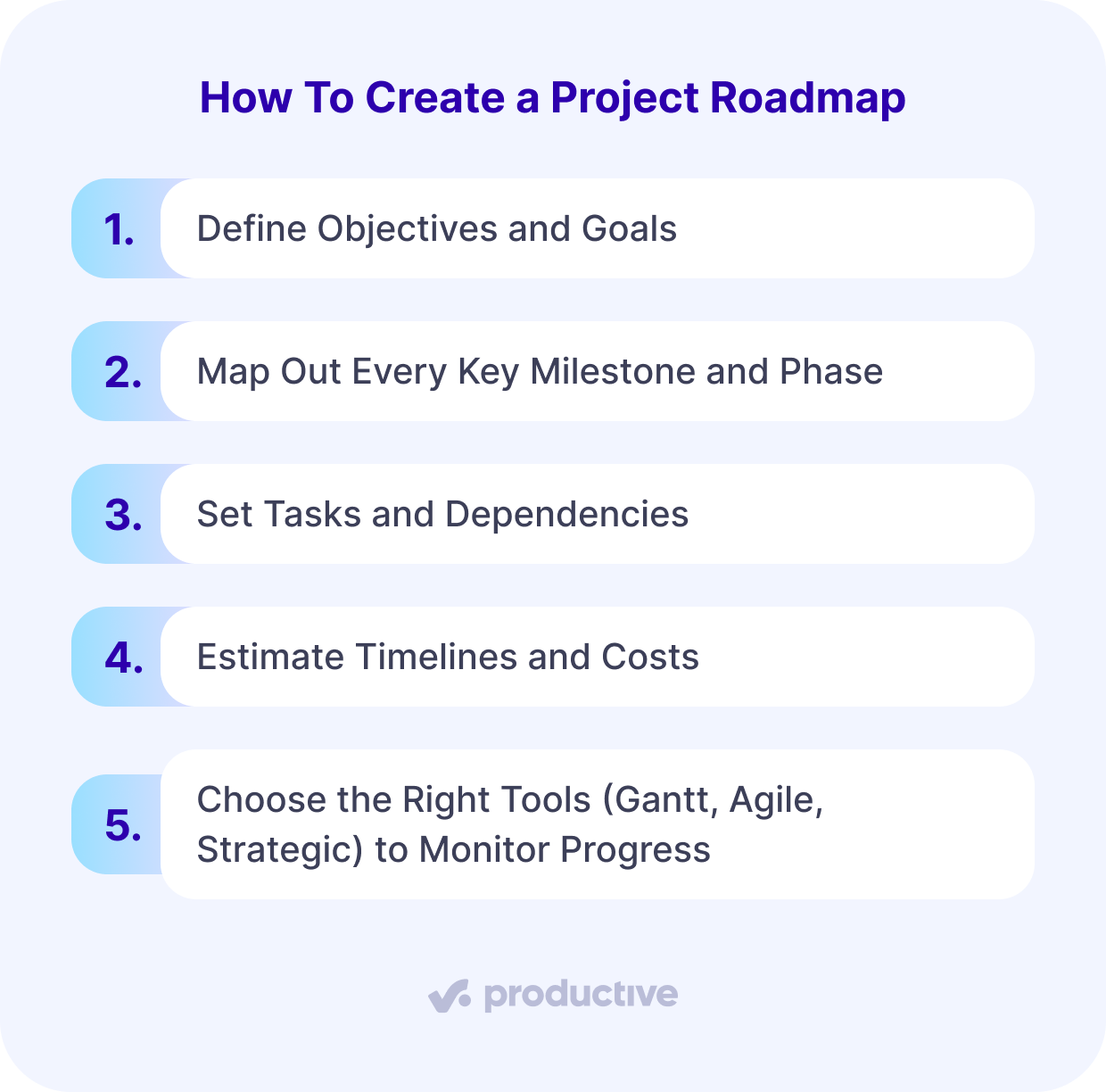
Using a visual roadmap or a practical roadmap template makes these steps easier to apply and share with your team. In the next section, we’ll break down this process step by step so you can apply it to your own projects.
Step 1: Define Objectives and Goals
When you define objectives and goals, write them down in simple, measurable terms so your team knows exactly what success looks like.
A strong objective could be “Increase customer retention by 15% in the next quarter,” while a weak one would be “Make customers happier.” A clear goal could be “Launch the redesigned website by June 1st,” while a poor goal would be “Work on improving the website.”
Use Productive to track these objectives and goals across projects so everyone stays aligned and progress is visible to the whole team.
Step 2: Map Out Every Key Milestone and Phase
When you map out milestones and project phases, be clear and specific so you and your team can measure progress without guessing.
A good example is breaking a product launch into project phases like research, design, development, testing, and release, and adding concrete milestones such as “user research completed” or “beta version deployed.”
A poor example would be listing a vague phrase like “work on design” with no deliverables or deadlines. In Productive, you can assign milestones directly to phases, track their status, and keep every step visible and accountable for the team.
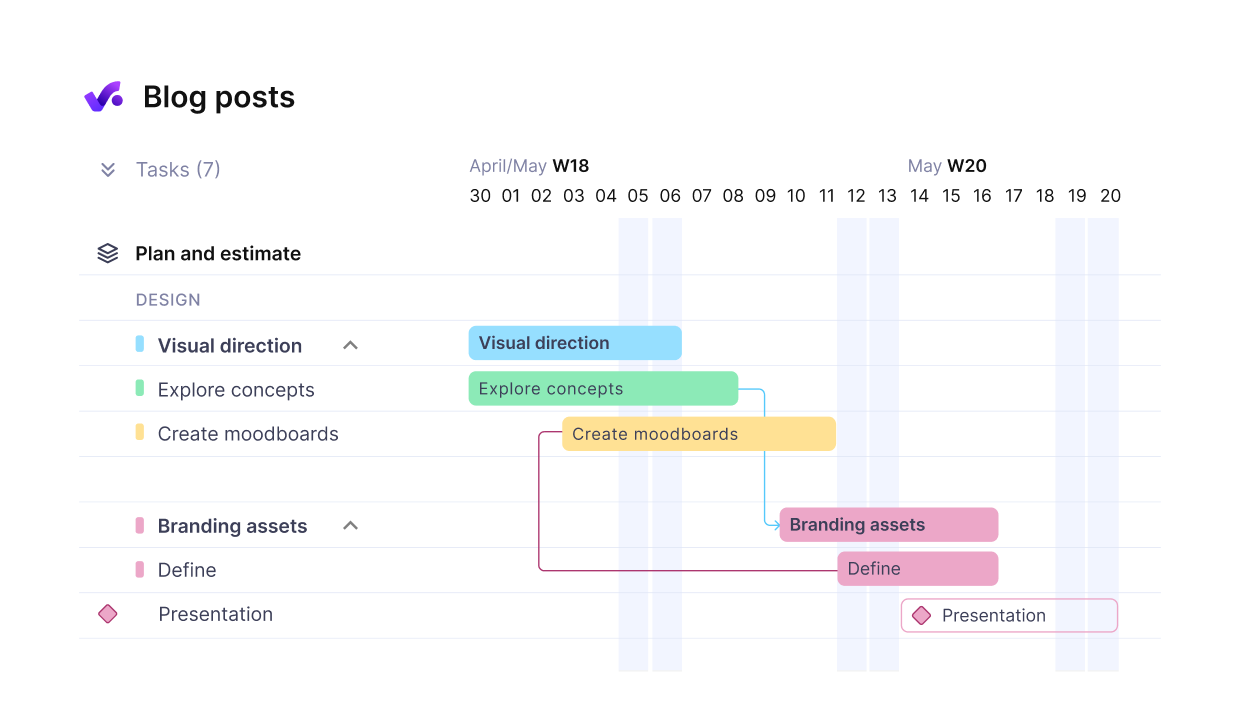
Use Productive’s Gantt charts to map out tasks with dependencies.
Step 3: Set Tasks and Dependencies
When you set tasks, link each one to its dependencies so you and your team can see the correct order of work. A good example is: “Task A: draft wireframes” must be completed before “Task B: get client approval,” which must be done before “Task C: start development.”
A bad example is listing all three tasks without showing the dependency order, which creates confusion and delays. In Productive, you can connect tasks with dependencies directly on the timeline so everyone knows what comes first and nothing falls through the cracks.

Add team members on dependent tasks with clear descriptions and to-do lists.
Step 4: Estimate Timelines and Costs
When you estimate timelines and costs, break the project into realistic chunks of time and assign clear budgets for each phase.
A good example is planning a development phase to last six weeks with a defined budget for developer hours and software licenses. A bad example would be saying “development will take a while” without assigning dates or costs, which leaves no baseline to measure against.
In Productive, you can use the schedule and budget to create accurate estimates and track actual costs against your project plan. In case you need extra help here, head over to our best project estimations techniques guide.
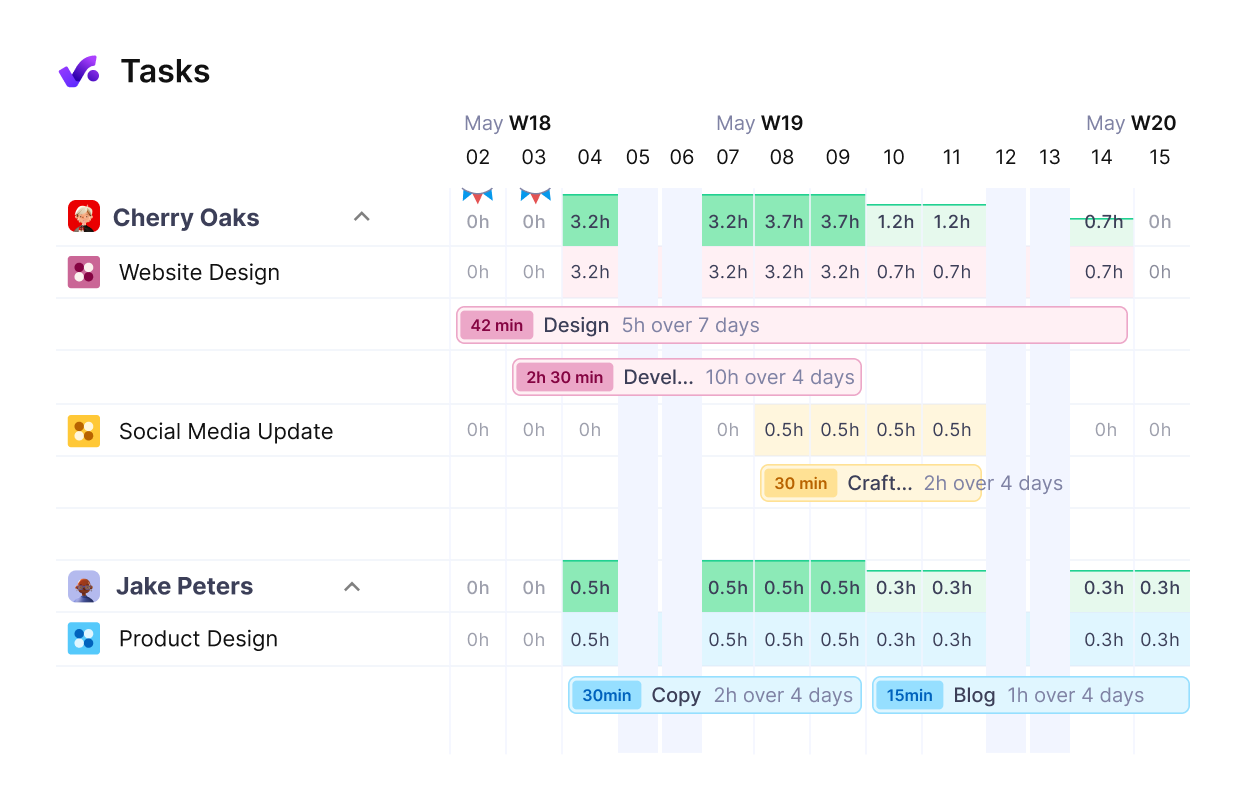
Add team members on dependent tasks with clear descriptions and to-do lists.
Step 5: Choose the Right Tools (Gantt, Agile, Strategic) to Monitor Progress
When you choose the right tools to monitor progress, match the tool to your project’s needs and workflow. For example, use a Gantt chart maker if your project requires strict timelines and dependencies, or an Agile PM tool if you need flexibility for iterative work.
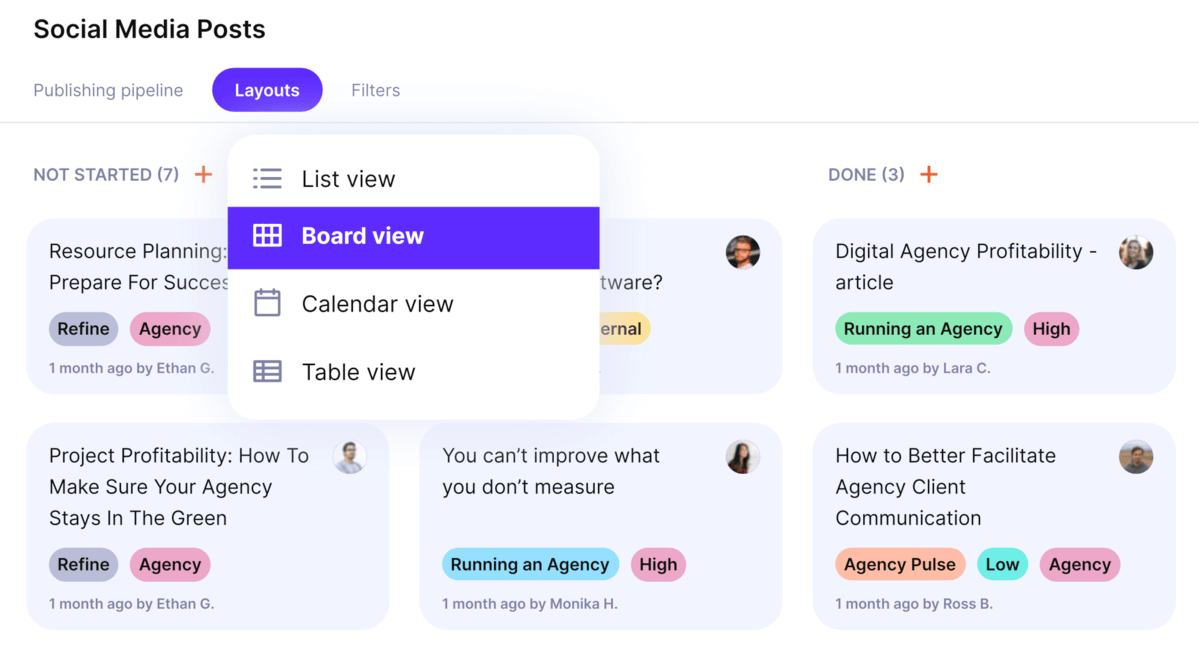
Easily switch Productive’s Kanban boards or timeline views.
A technology roadmap is helpful when managing IT or system upgrades, while a strategic roadmap works best for long-term planning. In Productive, you can combine these views in one place, switching between Gantt charts, Kanban boards, and timelines so your team members always have the right perspective.
Plan and execute projects with Productive
What Are the Benefits of Project Roadmaps?
A project roadmap brings clarity to the work ahead, reduces risk by surfacing potential issues early, and improves prioritization across the project lifecycle through better strategic planning. These benefits translate into reliable milestone tracking, a single source of truth for project information, and a sharper focus on what matters most.
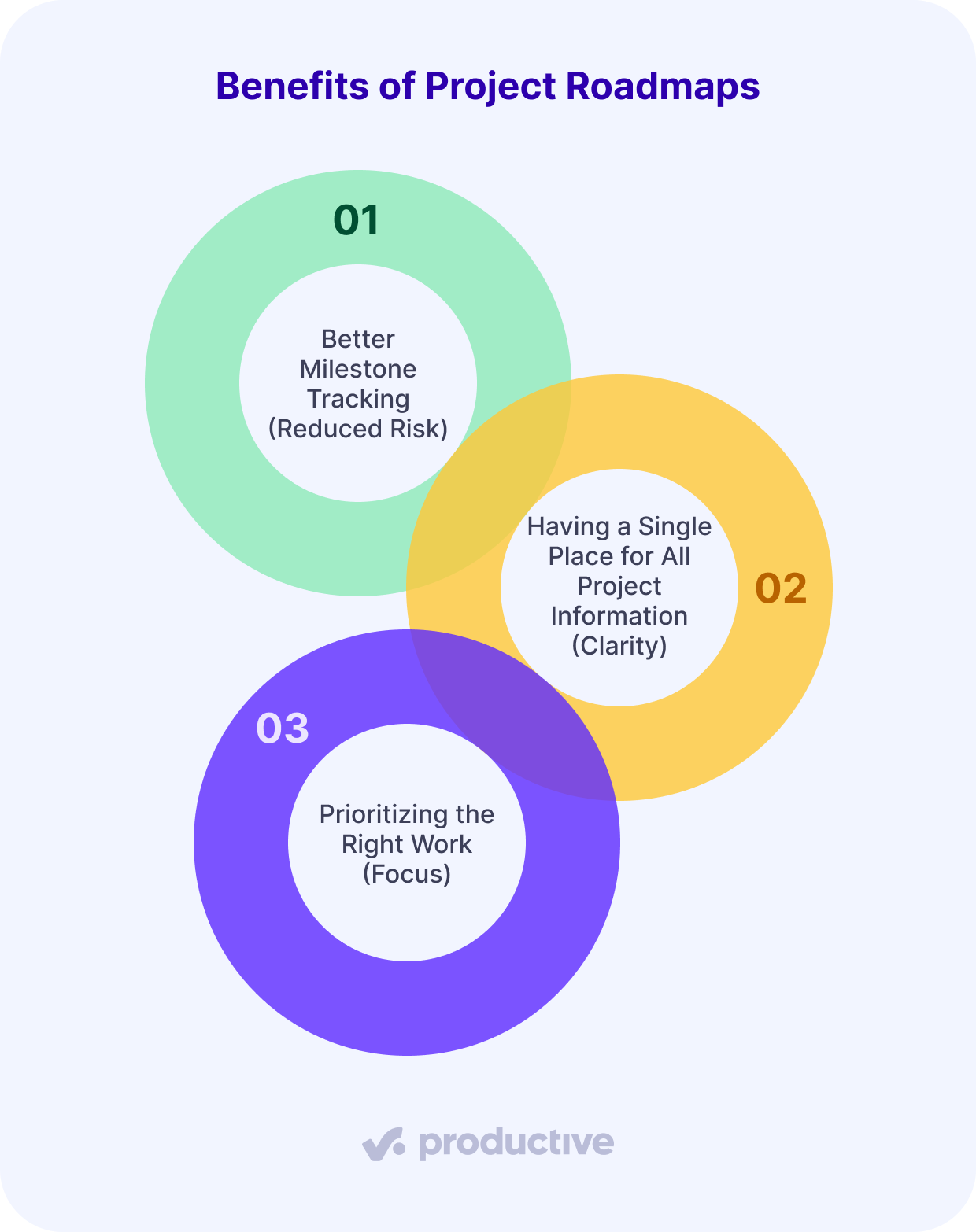
Better Milestone Tracking (Reduced Risk)
Roadmaps reduce risk by linking goals to specific project milestones, so teams can spot delays early and adjust before they threaten delivery. For example, if a milestone for regulatory approval is missed, the roadmap makes the risk visible immediately, helping leaders reallocate time or resources.
Tracking milestones this way improves the odds of finishing projects successfully and on time.
Having a Single Place for All Project Information (Clarity)
Roadmaps bring every detail into one central document, so teams and stakeholders don’t have to search through scattered information or emails. This single source of truth makes it easier to see priorities and confirm that deliverables are on track.
For example, when all phases of a product launch are shown in one product roadmap, everyone knows what’s done and what’s coming next.
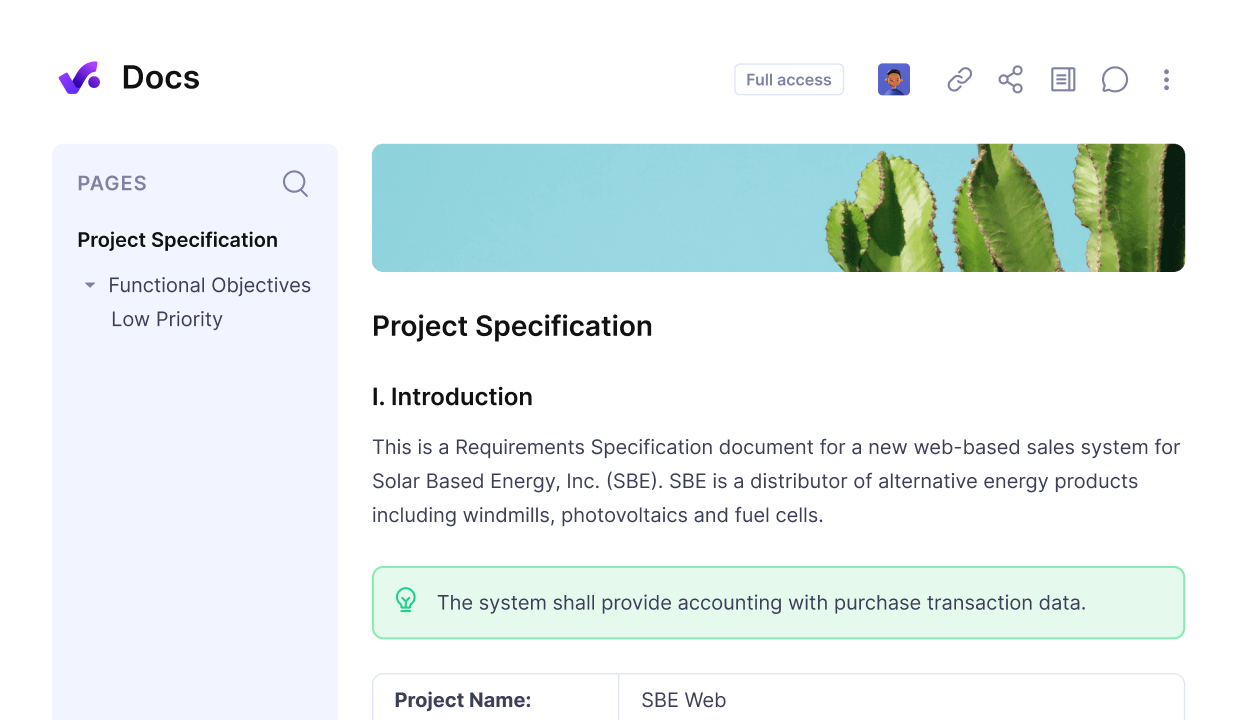
Productive centralizes all project documentation, so everyone on the team can share, edit and collaborate on docs.
Prioritizing the Right Work (Focus)
A roadmap shows the project order of milestones and deliverables, so that teams focus on what matters most instead of reacting to the loudest request. This better prioritization ensures that limited time and resources are spent on high-value tasks.
For example, if two features are planned but only one supports the overall project goals, the roadmap makes it clear which one should come first.
What Are Challenges Building a Project Roadmaps + How To Solve Them?
A common challenge when building a project roadmap is making it not overly detailed or too vague, relying on outdated data, or failing to get buy-in. All of these weaken planning project efforts and create gaps in project scheduling.
To understand these challenges better, we’ll break them down in a simple table overview, look at their root causes and impacts, and then walk through how to solve each of them.
| Challenge | Why It Happens? | Impact | How to Solve? |
|---|---|---|---|
| Overcomplicating | Trying to include every task and detail instead of focusing on the big picture | Teams lose sight of priorities and waste time on unnecessary details | Keep the roadmaps high-level and pair it with a detailed project plan. Review quarterly to ensure only major milestones and goals are included. |
| Being Too Vague | Leaving out key objectives or deliverables to avoid committing | Stakeholders don’t know what success looks like and can’t align on the direction | Define clear goals and expected project deliverables. Use a template to ensure nothing critical is left out. |
| Outdated Data | Roadmaps are not updated when schedules or priorities change | Creates false confidence and leads to missed deadlines | Schedule regular check-ins to refresh data. Use a collaborative tool like Productive so updates automatically sync across the team. |
| Lack of Buy-in | Stakeholders aren’t involved in roadmap creation | Results in low adoption and resistance to project direction | Involve stakeholders early and link it to agreed project goals so everyone feels ownership. |
Usual Roadmap Mistakes and How To Fix Them
After looking at the common challenges, it’s also worth reflecting on the underlying mistakes that often cause them. These mistakes usually come down to overcomplicating roadmaps, leaving out important details, or not keeping them updated.
Below is a simple table that shows the most common mistakes, why they happen, and how to fix them.
| Mistake | Why It Happens? | How to Fix? |
|---|---|---|
| Being too focused on details | Teams try to capture every detail instead of keeping the big picture visible | Keep it high-level, focus on goals and milestones, and use a detailed project plan for execution. |
| Ignoring Task Dependencies | Dependencies between tasks are not shown or managed | Map out dependent tasks clearly. In Productive, use the timeline view to visualize dependencies and avoid bottlenecks. |
| Not Updating Regularly | Roadmap is created once and left unchanged as priorities shift | Set regular review points. Use Productive so updates sync automatically across your team. |
| Lack of Stakeholder Input | Key stakeholders aren’t included early enough | Involve them from the start and present the roadmap visually so they can give feedback and feel ownership. |
| Vague Deliverables | Goals and outputs are not clearly defined | Clearly state objectives and project deliverables. A template can help make sure nothing essential is missed. |
Example of a Roadmap for Projects
Here’s a roadmap example that puts the earlier steps into practice. This example shows how objectives, milestones, deliverables, and timelines work together in practice, so you can see what a complete roadmap looks like and use it as a model for your projects.
Tech Roadmap Example
- Strategic objectives: Upgrade all company servers by the end of Q2 to improve system performance and security.
- Steps and phases: Research vendors (2 weeks), procurement (4 weeks), installation (6 weeks), testing (2 weeks).
- Milestones: “Vendor selected,” “hardware delivered,” “servers installed,” “systems tested and approved.”
- Deliverables: Updated technical documentation, installed servers, completed test reports.
- Timeline: Procurement starts in March, installation runs through April and May, and testing is completed in June.
What Can You Learn From This Example?
In this example, the objective is clear, the steps are phased, the milestones are concrete, the deliverables are specific, and the project timeline is defined, giving IT teams a direction they can act on.
The developer sees exactly what comes first, what outputs prove completion, and when each phase should finish.
What Are the Best Tools for Building Project Roadmaps?
The best tools for building project roadmaps are project management platforms that give you both high-level visibility and day-to-day control. You should choose all-in-one project management software over basic PM tools because they go beyond timelines and task lists.
They cover the essentials that teams often overlook, such as tracking finances, giving clients access through secure portals, and consolidating reporting and collaboration.
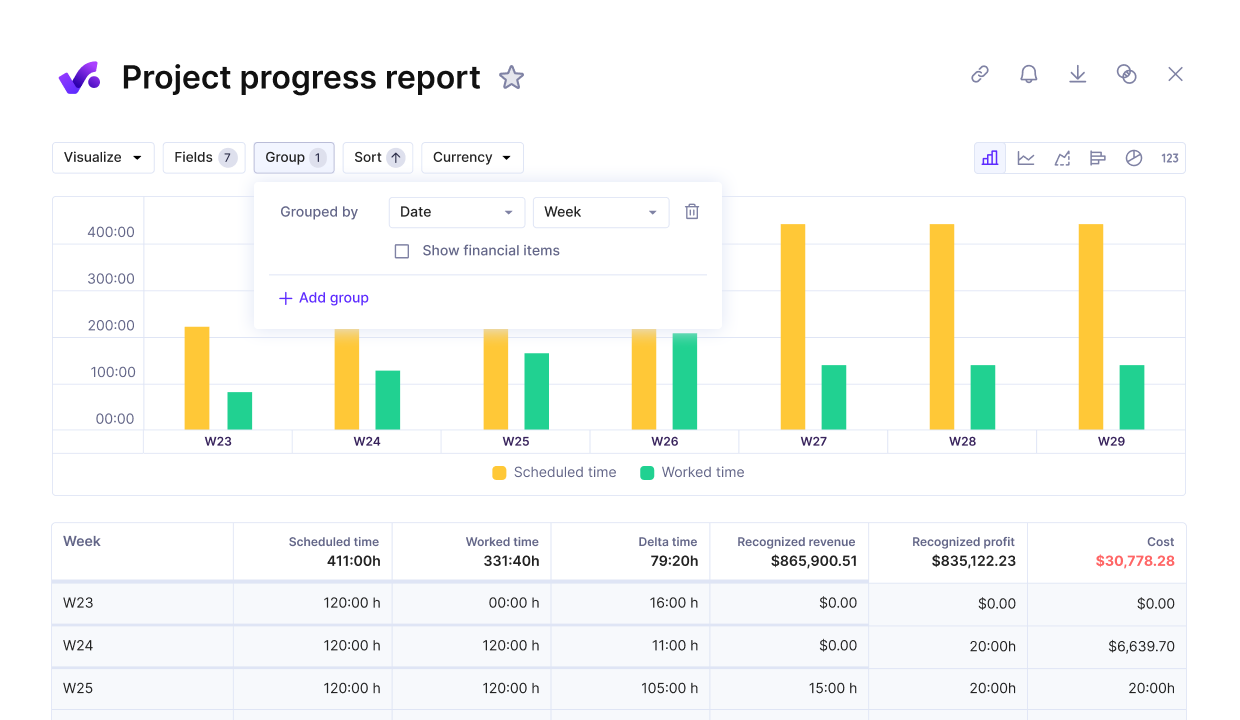
Track progress in real-time against other key metrics like costs.
Without these features, teams end up patching together scattered tools, wasting time and risking errors. All-in-one platforms like Productive bring everything into a single system, so you can manage roadmaps, schedules, budgets, and client communication without jumping between apps.
We have a detailed guide about choosing your PM software, but for now, look out for tools that allow you to:
- Build and adjust a project schedule
- Manage project scheduling and dependencies
- Track progress against milestones and deliverables
- Share updates with stakeholders in real time
Final Takeaway
A project or product roadmap gives team members and stakeholders a single view of business goals, milestones, and timelines, helping everyone stay aligned and avoid costly surprises.
A clear roadmap also strengthens project management because it makes priorities visible and reduces the risk of missed deadlines or wasted resources.
Productive brings this all together in one all-in-one platform that unifies roadmaps, budgets, tasks, resource management, and planning, so you don’t need scattered tools.
Book a short demo to see how Productive can help you build roadmaps and manage your projects smarter.
Turn vague goals or timelines into clear roadmaps with Productive
Connect milestones, budgets, and resources to your roadmap. Visualize goals, dependencies, and key phases in real-time.
